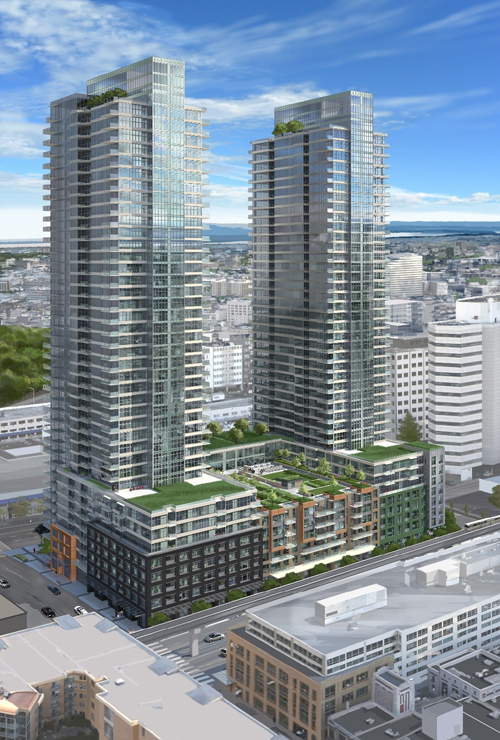Insignia
From Insignia website
With many buyers still wary of the arguably routinized construction defect litigation that hits most new condo projects, a relevant number do seem to be responding to the 707-unit project (the MLS shows 37 units pending since their launch in mid-September; 6 weeks ago). I’m impressed with the uptake, particularly given that the Insignia agreement calls for 5% of the purchase price converted to a non-refundable deposit at Mutual Acceptance and another 5% in September 2014. That’s right: 10% non-refundable, with no financing protections, likely six months before any product is delivered. Impressive.
The sales center staff has effectively argued the point that the buyer who commits to Insignia should want to know that all of their “neighbors” are similarly committed. They cite as guidance the early closing period at Escala, when a handful of buyers actually closed at their committed prices, while scores more headed for the exits (some with their earnest money).
So, they have certainly found a way to appeal to a relevant portion of the market. One of their methods is simplicity in pricing. They claim no negotiability. You want to pay less? Buy on a lower floor. You want another parking space? Buy a more expensive home that has additional parking allocated to it. I think this was a smart move.
It seems that the Buyer there will likely value at least one of the following:
-The Location: The closest “new” construction buildings (Enso, Escala, Mosler, etc) are at least two blocks away; mostly further
-Newness: Some people just prefer to purchase something that no one else has previously lived in.
-Developer: Some get excited about a developer, and just want to be a part of their vision
-Appreciation: The appeal of locking a price now with 5% down then adding another 5% in a year, and a hopeful higher value at closing, another six or so months later.
-Planning: Buying now with an 18 month delay of gratification may appeal to downsizers who need a plan, but also some time to execute.
If not those…there’s always the existing inventory.
670 New Condo Units in Belltown?!
Well, there goes the “there are no new condos coming out of the ground” argument. It looks like we can expect 335 new units by the end of 2014, with 335 more to follow if the developer feels that demand will support the supply. This underscores one of the challenges with assuming supply/demand-based appreciation in in-city condominiums; when there are empty lots around, there is potential for more supply. http://www.djc.com/news/co/12041770.html
Local Seattle press acknowledges shrinking downtown condo inventory
http://seattletimes.nwsource.com/html/businesstechnology/2018251763_condos21.html
The “news” isn’t all that much a surprise. The balanced nature of the article – reduced supply, increased demand, but acknowledging “shadow inventory” – is refreshing.
Q: Does the same (high activity) apply to condos as SFH?
Friend and Client Bruce posed this question on my FB business page (www.facebook.com/ThriveSeattle) after the last post. My answer:
Bruce, good question. While some condominiums are increasing in price (Escala had one listed at $1.750M and _raised_ the price to $1.825M and they say they have seen multiple offers on others), I don’t see the broader condo market doing the same. Activity has improved, though, from dismal to OK. Fears of “shadow” inventory seem more relevant in condos than in single family homes, and the buyer pool is smaller than it was several years ago. It used to be that we’d see a lot of younger buyers who thought of condo purchases as a sure-thing, equity-building stepping-stone to single family detached home ownership. Then, things changed. That pool of buyers either lost or saw friends lose, so they seem to be skipping that step, and going directly to townhomes and “affordable” single family detached (like the home featured in the piece).

 Facebook
Facebook
 Twitter
Twitter
 Pinterest
Pinterest
 Copy Link
Copy Link
